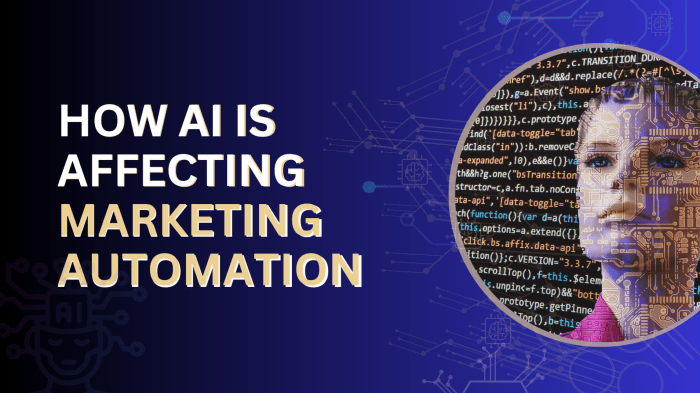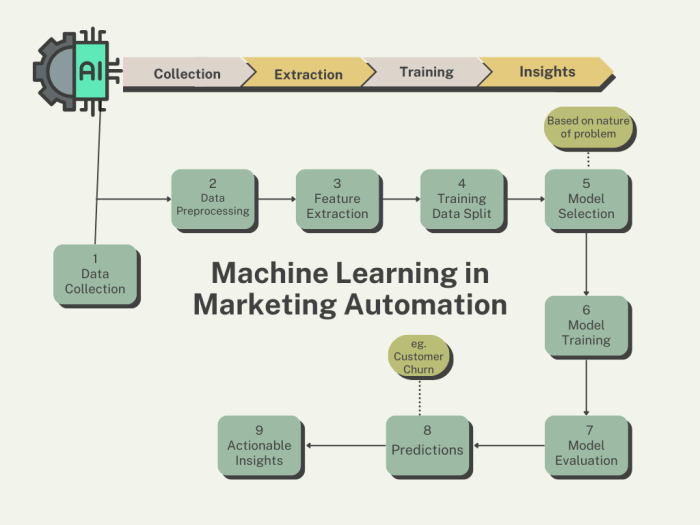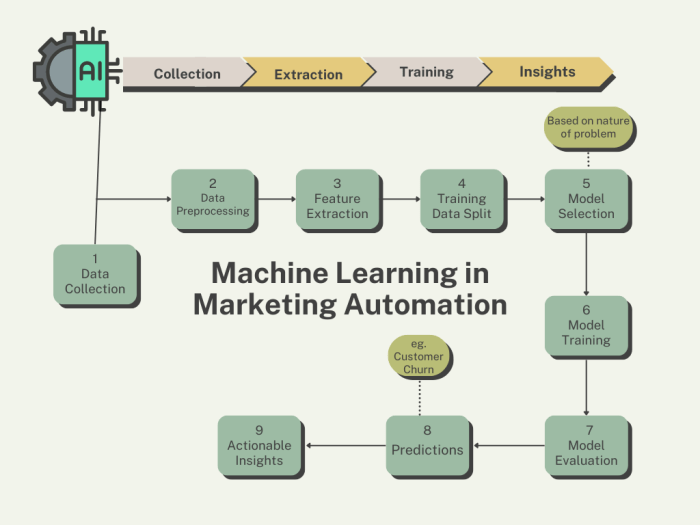The role of AI in marketing automation is rapidly transforming how businesses connect with customers. From sophisticated customer segmentation to personalized content creation and optimized campaigns, AI is revolutionizing the marketing landscape. This exploration delves into the key aspects of AI-powered marketing automation, examining its benefits, challenges, and future trends.
This comprehensive guide explores how AI algorithms analyze vast amounts of data to identify customer preferences and tailor marketing messages for maximum impact. We’ll also examine the ethical implications of using AI in marketing, including data privacy concerns and responsible implementation strategies.
Introduction to AI in Marketing Automation
Marketing automation is a sophisticated system designed to streamline and automate various marketing tasks, from email campaigns to social media posting. It essentially helps businesses manage and optimize their marketing efforts by automating repetitive processes, freeing up human resources for more strategic initiatives. This approach often involves software platforms that handle tasks such as lead nurturing, campaign management, and customer relationship management.Artificial intelligence (AI) is a broad field encompassing technologies that enable computers to mimic human intelligence, including learning, problem-solving, and decision-making.
AI applications span a wide range of industries, from healthcare to finance, and its integration into marketing automation represents a powerful step towards more personalized and effective campaigns. AI algorithms analyze vast amounts of data to identify patterns, predict customer behavior, and tailor marketing messages to individual preferences.
AI’s Role in Marketing Automation
AI significantly enhances marketing automation by adding a layer of intelligence and personalization. It allows businesses to move beyond simple automation to sophisticated, data-driven strategies. AI algorithms can analyze customer data, including browsing history, purchase patterns, and engagement metrics, to create highly targeted campaigns. This personalization leads to increased engagement, conversion rates, and customer satisfaction. AI-powered automation can also predict customer churn, enabling proactive intervention and retention strategies.
Comparison of Traditional and AI-Powered Marketing Automation
| Feature | Traditional Marketing Automation | AI-Powered Marketing Automation | Examples |
|---|---|---|---|
| Campaign Targeting | Based on broad demographics or predefined segments. | Utilizes complex algorithms to identify nuanced customer characteristics, including purchasing behavior, browsing history, and social media interactions, for hyper-personalized targeting. | Demographic targeting; Interest-based targeting. |
| Content Personalization | Generic, template-based content for all recipients. | Dynamically generates tailored content, including emails, product recommendations, and ads, based on individual customer preferences and past interactions. | Email campaigns with pre-filled templates; personalized product recommendations. |
| Predictive Analysis | Limited or no predictive capabilities. | Utilizes machine learning to forecast customer behavior, identify potential churn risks, and anticipate future needs. | Lead scoring models; churn prediction models. |
| Scalability | Can be challenging to scale for large volumes of customers. | Easily scales to handle massive datasets and large-scale campaigns. | Mass email campaigns; automated lead generation. |
AI-Driven Customer Segmentation
AI is revolutionizing marketing automation, and one key area of transformation is customer segmentation. By leveraging sophisticated algorithms, businesses can move beyond rudimentary demographic groupings to create incredibly precise customer segments. This granular understanding enables targeted marketing campaigns that resonate deeply with individual customer needs, boosting engagement and conversion rates.AI’s ability to analyze vast datasets and uncover hidden patterns empowers marketers to identify previously unknown customer segments, allowing for a more comprehensive and effective marketing strategy.
This refined understanding enables the development of highly personalized experiences, leading to improved customer lifetime value.
AI Methods for Customer Segmentation
Various AI methods are employed for customer segmentation, each with its strengths and weaknesses. Machine learning algorithms, including clustering techniques like K-means and hierarchical clustering, and classification algorithms such as decision trees and support vector machines, are frequently used to identify patterns and categorize customers. Deep learning models, with their ability to handle complex, unstructured data, can also be valuable tools for advanced segmentation.
These methods allow for the discovery of subtle correlations and preferences that traditional methods might miss.
AI Analysis for Accurate Segments
AI can analyze customer data far beyond basic demographics. AI algorithms can consider purchase history, browsing behavior, engagement with marketing materials, and even social media interactions to build comprehensive customer profiles. These profiles are crucial in creating accurate segments, as they go beyond surface-level characteristics to understand the motivations and needs of each segment. For instance, a customer who frequently buys organic products and actively engages with sustainability-focused content on social media would be categorized differently than a customer who primarily purchases electronics and rarely interacts with online discussions about sustainability.
These detailed insights enable the creation of segments that truly reflect customer preferences and behaviors.
AI-Powered Segmentation and Targeting
AI-powered segmentation enhances marketing campaign targeting significantly. Marketers can tailor messaging, product recommendations, and offers specifically to each segment. For example, a segment interested in eco-friendly products can receive targeted ads for sustainable alternatives, while a segment interested in gaming can be offered promotions on gaming accessories. This personalized approach greatly increases the effectiveness of marketing campaigns, driving higher engagement and conversion rates.
Examples of AI-Driven Customer Personas
AI can generate detailed customer personas that go beyond simple demographic data. These personas can include insights into customer motivations, values, and pain points. For example, an AI-generated persona for a segment focused on luxury travel might reveal a preference for personalized experiences, a desire for exclusivity, and a willingness to pay a premium for high-quality service. Another persona for a segment interested in budget-friendly electronics might highlight a focus on value, a preference for reviews, and a need for cost-effective options.
Advantages and Disadvantages of AI Segmentation Techniques
| Technique | Advantages | Disadvantages | Use Cases |
|---|---|---|---|
| K-means Clustering | Simple to implement, computationally efficient, effective for large datasets | Requires specifying the number of clusters, can be sensitive to outliers, may not capture complex relationships | Customer grouping based on purchasing behavior, website navigation patterns |
| Decision Trees | Easy to interpret, provides clear rules for segmenting customers, handles both numerical and categorical data | Can be prone to overfitting, may not generalize well to new data, less efficient for large datasets | Identifying customer segments based on product preferences, purchase history, and demographics |
| Support Vector Machines | Effective for high-dimensional data, can handle complex relationships between variables, good at classifying customers | Computationally intensive, can be challenging to interpret the results, may not perform well with highly imbalanced datasets | Segmenting customers based on their likelihood of making a purchase, predicting customer churn |
| Deep Learning | Handles complex, unstructured data (e.g., text, images), can uncover hidden patterns, high accuracy | Difficult to interpret, requires significant computational resources, black box nature of some models | Segmenting customers based on social media activity, product reviews, and customer feedback |
AI-Powered Content Creation and Personalization

AI is revolutionizing marketing content creation and personalization, moving beyond generic templates to deliver highly targeted and engaging experiences. This capability allows businesses to craft content tailored to individual customer preferences, fostering stronger connections and driving higher conversion rates. By leveraging vast datasets and sophisticated algorithms, AI can analyze customer behavior, preferences, and demographics to generate customized content.AI algorithms can analyze massive amounts of data to identify patterns and trends, enabling the creation of highly relevant and engaging content.
This data-driven approach ensures that marketing efforts resonate with the target audience, leading to a more efficient and effective marketing strategy. This personalization enhances customer experience and builds stronger relationships.
AI Content Generation Methods
AI algorithms utilize natural language processing (NLP) and machine learning (ML) to generate marketing content. NLP allows the AI to understand and interpret human language, enabling it to create text that is grammatically correct, contextually relevant, and engaging. ML algorithms learn from existing content to identify patterns, styles, and writing conventions, which helps in creating content that mirrors the desired tone and style.
These algorithms can generate various content formats, from social media posts to emails, blog posts, and even ad copy.
Personalized Content Creation
Creating personalized content involves tailoring marketing materials to specific customer profiles. This requires analyzing customer data to understand their individual needs, preferences, and pain points. AI tools can identify customer segments based on demographics, purchase history, website interactions, and other relevant data points. Once customer segments are defined, AI can generate content that resonates with each segment’s unique characteristics.
This can include different language, tone, product recommendations, and offers.
Enhancing Content Relevance and Engagement
AI enhances content relevance by ensuring that the message resonates with the intended audience. By analyzing customer data, AI can identify the specific content formats, topics, and styles that will be most engaging for each individual or segment. This data-driven approach ensures that the marketing message is tailored to the specific needs and interests of the customer, increasing the chances of conversion and engagement.
This is more effective than using generic, mass-produced content.
AI Tools for Content Generation
Various AI tools cater to different content formats. For social media posts, tools like Jasper, Copy.ai, and Rytr can generate engaging captions, hashtags, and creative content based on user inputs. For email marketing, similar tools can create personalized subject lines, body copy, and calls to action. For website copy, AI can generate compelling descriptions, product pages, and landing pages.
Tools like Grammarly and ProWritingAid can further enhance the quality and style of generated content.
AI is rapidly changing the landscape of marketing automation, offering incredible efficiency and personalized experiences. This is especially relevant given that companies like clicta digital agency pledges 1 of all sales to environmental causes , demonstrating a commitment to ethical and sustainable practices. Ultimately, integrating AI into marketing automation strategies will be crucial for staying ahead of the curve in a competitive market.
Steps in AI-Driven Content Personalization
| Step | Description | Example | AI Tool |
|---|---|---|---|
| 1. Data Collection and Analysis | Gather data on customer behavior, preferences, and demographics. | Analyze website browsing history, purchase history, and social media interactions. | Google Analytics, CRM systems |
| 2. Customer Segmentation | Divide customers into groups based on shared characteristics. | Group customers by age, location, purchasing behavior, and interests. | Marketing automation platforms |
| 3. Content Generation | Create tailored content for each segment based on their preferences. | Create different product recommendations for different customer segments. | Jasper, Copy.ai |
| 4. Content Delivery and Optimization | Deliver personalized content to the right audience and track results. | Send targeted emails with personalized product recommendations to specific customer segments. Monitor click-through rates and conversions. | Email marketing platforms, website analytics tools |
AI for Marketing Campaign Optimization: The Role Of Ai In Marketing Automation
AI is rapidly transforming marketing campaign optimization, moving beyond simple rules-based systems to sophisticated algorithms that learn and adapt in real-time. This dynamic approach allows marketers to achieve higher conversion rates, improved ROI, and a more personalized customer experience. By leveraging AI’s ability to analyze vast datasets, identify patterns, and predict future outcomes, businesses can fine-tune their strategies for maximum impact.AI algorithms meticulously analyze campaign performance across various touchpoints, from website interactions to email opens and click-through rates.
This analysis goes beyond simple metrics to uncover deeper insights into customer behavior and preferences, allowing marketers to make data-driven adjustments.
AI’s Real-Time Campaign Optimization
AI can dynamically adjust marketing campaigns in real-time, responding to changing market conditions and customer behavior. This real-time optimization is a significant advantage over traditional methods that rely on scheduled adjustments. By constantly monitoring key performance indicators (KPIs), AI can identify trends and opportunities for improvement, leading to immediate adjustments to messaging, targeting, and even campaign budget allocation.
Key Performance Indicators (KPIs) for AI-Driven Optimization
AI systems can track a wide range of KPIs, including website traffic, conversion rates, customer lifetime value (CLTV), and return on ad spend (ROAS). This comprehensive data allows AI to identify which aspects of the campaign are performing well and which require attention. Furthermore, AI can predict future performance based on historical data and current trends, allowing proactive adjustments to maximize campaign effectiveness.
AI-Driven Campaign Strategy Adjustments
AI analyzes campaign performance data to identify areas needing adjustments. Based on the insights gathered, AI can modify targeting parameters, adjust messaging, optimize ad spend allocation, and refine creative elements. These adjustments are not arbitrary; they are driven by a sophisticated understanding of customer behavior and campaign performance. For example, if a specific ad group is underperforming, AI can automatically reallocate budget to higher-performing groups, improving the overall ROI.
Examples of AI-Driven Campaign Adjustments
Consider a retail company running a social media campaign. AI detects that a particular image ad is underperforming, with low engagement rates and conversion rates. The AI then automatically creates alternative versions of the ad with different visuals or captions, based on user data and the types of images and captions that tend to perform well. This adjustment happens in real-time, without manual intervention.
Subsequently, the AI tracks the performance of the adjusted ads, and if a new version performs better, it adjusts the campaign further, ensuring a constant optimization cycle. In another instance, an AI-driven campaign might adjust the pricing strategy for a product based on real-time demand and competitor pricing.
Process of AI-Driven Campaign Optimization
| Stage | AI Action | Data Used | Result |
|---|---|---|---|
| Data Collection | Collects data on campaign performance, customer behavior, and market trends. | Website analytics, CRM data, social media engagement, competitor data. | Comprehensive data set for analysis. |
| Performance Analysis | Analyzes data to identify trends, patterns, and areas for improvement. | Conversion rates, click-through rates, customer demographics, campaign budget allocation. | Pinpoints strengths and weaknesses of the campaign. |
| Real-time Adjustment | Automatically adjusts campaign elements based on analysis, including targeting, messaging, and budget allocation. | Identified trends, historical data, predicted future performance. | Optimized campaign in real-time, leading to immediate performance improvements. |
| Performance Monitoring | Continuously monitors the effectiveness of adjustments and refines strategies based on ongoing results. | Updated performance data, feedback from customer interactions. | Dynamic campaign optimization cycle that adapts to changing circumstances. |
AI and Predictive Analytics in Marketing
Predictive analytics, powered by AI, is revolutionizing marketing strategies by enabling businesses to anticipate customer behavior and needs. This capability allows for more targeted campaigns, optimized resource allocation, and ultimately, increased ROI. By understanding the factors influencing future trends, marketers can proactively shape their strategies and stay ahead of the curve.AI models are trained on vast datasets of customer interactions, purchase history, demographics, and online behavior.
Through complex algorithms, these models identify patterns and trends, enabling accurate predictions about future customer actions. This predictive power is transforming how businesses understand and engage with their target audiences.
Predicting Future Customer Behavior
AI models analyze historical data to identify correlations and patterns in customer behavior. This analysis reveals trends, such as which customers are most likely to churn, which products are most appealing to specific segments, and which marketing channels yield the best results. By understanding these patterns, marketers can proactively address potential issues and tailor their strategies for optimal impact.
For instance, if an AI model predicts a high likelihood of customer churn, targeted retention campaigns can be initiated to prevent customer loss.
Anticipating Customer Needs
Predictive analytics empowers marketers to anticipate customer needs before they are explicitly expressed. By analyzing browsing history, purchase patterns, and social media activity, AI models can identify emerging trends and preferences. This allows marketers to develop products, services, and marketing campaigns that align with current and future customer demands. A retail company, for example, might use predictive analytics to anticipate a surge in demand for a particular product based on online searches and social media buzz, allowing them to stock up in advance.
AI-Powered Predictions for Marketing Strategies
AI-powered predictions inform a wide array of marketing strategies. For instance, an AI model might suggest tailoring messaging for a specific customer segment based on predicted purchase intent. This personalized approach can significantly increase conversion rates. Furthermore, AI can optimize pricing strategies by predicting customer price sensitivity and identifying opportunities for targeted promotions. This approach can significantly boost revenue.
Forecasting Sales and Marketing ROI
AI models can project future sales and marketing ROI. By analyzing past performance data and external factors, AI can estimate the potential return on investment for different marketing campaigns. These projections help marketers allocate resources effectively and make data-driven decisions. For example, if an AI model predicts a low ROI for a particular social media campaign, resources can be redirected to more promising channels.
Creating Detailed Marketing Forecasts
AI enables the creation of detailed marketing forecasts that consider various factors, including economic conditions, competitor activities, and market trends. These forecasts are crucial for long-term planning and resource allocation. For instance, a detailed marketing forecast might predict a decline in sales during a specific season, prompting the development of countermeasures like promotional campaigns.
Comparison of Predictive Models in Marketing Automation, The role of ai in marketing automation
| Model Type | Description | Strengths | Limitations |
|---|---|---|---|
| Regression Models | Predict a continuous variable based on independent variables. | Relatively simple to implement, good for understanding relationships between variables. | May not capture complex non-linear relationships. |
| Classification Models | Predict a categorical variable based on independent variables. | Effective for predicting customer segments or future behavior categories. | Can be less accurate for predicting continuous values. |
| Time Series Models | Predict future values based on historical trends. | Excellent for forecasting sales and demand, understanding seasonal patterns. | Assumes historical patterns will continue, may not adapt to sudden changes. |
| Neural Networks | Complex models that learn from data to predict various outcomes. | High accuracy, capable of handling complex relationships and non-linearity. | Can be computationally expensive, difficult to interpret. |
Ethical Considerations and Data Privacy

AI-driven marketing automation, while offering powerful tools for personalization and optimization, necessitates careful consideration of ethical implications and data privacy. Effective implementation requires a robust understanding of ethical frameworks and a commitment to responsible data handling. Ignoring these aspects can lead to reputational damage, legal challenges, and a loss of customer trust.
AI is revolutionizing marketing automation, streamlining processes and boosting efficiency. A prime example of this is Kendra Cannoy’s success story, success story kendra cannoy , showcasing how AI-powered tools helped her dramatically improve lead generation and customer engagement. Ultimately, AI’s impact on marketing automation is undeniable, driving significant positive change for businesses.
Importance of Ethical Considerations
Ethical considerations in AI marketing are crucial for maintaining a positive brand image and fostering customer trust. Unethical practices can damage a company’s reputation, leading to boycotts and a loss of market share. Transparency in data usage and clear communication about how AI is employed are vital to build trust and maintain ethical standards. Moreover, ethical considerations ensure that AI systems are used to enhance the customer experience rather than exploit or manipulate consumers.
Role of Data Privacy Regulations
Data privacy regulations, like GDPR and CCPA, play a critical role in governing how businesses collect, process, and utilize customer data in AI marketing. Companies must comply with these regulations to avoid legal penalties and maintain customer trust. Understanding the specific requirements of these regulations, including consent mechanisms, data minimization, and data security protocols, is essential for responsible AI marketing practices.
Ethical Issues in AI Marketing Automation
Bias in algorithms is a significant ethical concern. AI models trained on biased data can perpetuate and amplify existing societal biases in marketing campaigns. For example, a model trained on historical data that shows women are less likely to purchase a certain product might result in targeted ads being less frequently shown to women. Another ethical issue is the potential for manipulation through highly personalized, potentially deceptive, advertising.
Over-reliance on AI-driven personalization could lead to consumers feeling monitored or manipulated, thus damaging trust.
Strategies for Ensuring Data Privacy in AI Marketing
Implementing robust data security measures, including encryption and access controls, is crucial. Data anonymization and pseudonymization techniques can help protect sensitive information. Regular audits of AI systems for bias and potential harm can help mitigate ethical risks. Furthermore, obtaining explicit consent for data collection and use, coupled with clear communication about how data is used, is essential.
AI’s role in marketing automation is huge, streamlining tasks and boosting efficiency. But to truly maximize your results, understanding the 4 principles of successful Snapchat marketing, like engaging visuals and interactive content ( the 4 principles of successful snapchat marketing ), is crucial. This knowledge, combined with AI-powered tools, can supercharge your marketing campaigns, ultimately leading to better conversions and ROI.
Ethical Guidelines for Using AI in Marketing
| Category | Description | Examples | Consequences of Violation |
|---|---|---|---|
| Transparency | Clearly communicate how AI is used in marketing, including data collection practices and decision-making processes. | Provide detailed privacy policies and explain the role of AI in personalized recommendations. | Loss of customer trust, reputational damage, legal challenges. |
| Fairness and Non-discrimination | Ensure AI systems do not perpetuate or amplify existing societal biases in marketing campaigns. | Use diverse and representative datasets to train AI models. Conduct regular audits for bias in algorithms. | Discrimination lawsuits, negative publicity, decreased market share. |
| Accountability | Establish clear lines of responsibility for AI-driven marketing decisions and actions. | Identify individuals or teams responsible for AI system maintenance and performance. | Lack of recourse in case of ethical violations, difficulties in addressing complaints. |
| Privacy | Comply with relevant data privacy regulations and protect sensitive customer data. | Obtain explicit consent for data collection and use. Employ strong data security measures. | Data breaches, legal penalties, reputational damage, loss of customer trust. |
Future Trends in AI Marketing Automation
The realm of marketing automation is undergoing a rapid transformation, driven by the ever-evolving capabilities of artificial intelligence. AI is no longer a futuristic concept; it’s a present reality, reshaping how businesses interact with customers and optimize their marketing efforts. This shift is characterized by increased personalization, enhanced efficiency, and a deeper understanding of consumer behavior. The future promises even more sophisticated applications of AI, pushing the boundaries of what’s possible in the marketing sphere.AI’s impact on future marketing strategies will be profound.
From automated campaign optimization to hyper-personalized content generation, AI will empower marketers to achieve unprecedented levels of efficiency and effectiveness. The focus will shift from broad, generic campaigns to targeted, individual interactions, resulting in higher conversion rates and stronger customer relationships.
Emerging Trends in AI-Powered Marketing Tools
AI-powered marketing tools are rapidly evolving, with a focus on advanced functionalities and seamless integration with existing marketing platforms. Expect tools to become more sophisticated in their ability to analyze data, predict outcomes, and tailor marketing messages to individual customer needs. These tools will not only automate repetitive tasks but also provide actionable insights that guide strategic decision-making.
Advancements in AI-Driven Content Creation and Personalization
AI’s role in content creation is set to expand beyond simple template filling. Expect more sophisticated AI tools to generate personalized content tailored to individual customer preferences, including customized product recommendations, tailored email sequences, and dynamic website content. This personalized approach fosters stronger customer engagement and loyalty, ultimately driving higher conversion rates.
AI’s Impact on Marketing Campaign Optimization
AI algorithms will play a pivotal role in optimizing marketing campaigns in real-time. By continuously analyzing campaign performance data, AI can adjust strategies and allocate resources dynamically to maximize ROI. Real-time adjustments based on customer behavior and campaign response will become the norm, enabling marketers to respond swiftly to changing market conditions and consumer preferences. This dynamic approach is crucial in today’s fast-paced marketing environment.
Future Scenarios and Implications of AI in Marketing Automation
The future of AI in marketing automation paints a picture of a highly personalized and automated landscape. Businesses will be able to understand customer needs and preferences with unprecedented accuracy, leading to more effective and targeted marketing campaigns. Furthermore, AI will automate repetitive tasks, freeing up marketers to focus on strategic initiatives and creative endeavors. This paradigm shift will demand a new skillset for marketers, requiring them to collaborate effectively with AI systems to achieve optimal results.
Predicted Evolution of AI-Driven Marketing Tools
| Current Capabilities | Near-Future Capabilities | Mid-Future Capabilities | Long-Term Potential |
|---|---|---|---|
| Basic segmentation based on demographics | Segmentation based on behavior and predictive modeling | Segmentation based on real-time context and micro-moments | Segmentation based on emotional intelligence and predictive psychographics |
| Automated email marketing | Personalized email sequences and dynamic content | AI-generated email copy and subject lines | AI-driven email conversation and personalized chatbots |
| Basic campaign analysis | Real-time campaign optimization and A/B testing | Predictive campaign performance and resource allocation | Autonomous campaign management and automated response to market changes |
| Basic data analysis | Advanced data visualization and actionable insights | Predictive analytics and proactive marketing | Prescriptive analytics and automated decision-making |
Last Recap
In conclusion, AI is reshaping marketing automation, driving personalization, efficiency, and predictive capabilities. While ethical considerations and data privacy remain crucial, the potential of AI to enhance marketing strategies is undeniable. Businesses that embrace AI-powered solutions are poised to gain a competitive edge in today’s dynamic market.






